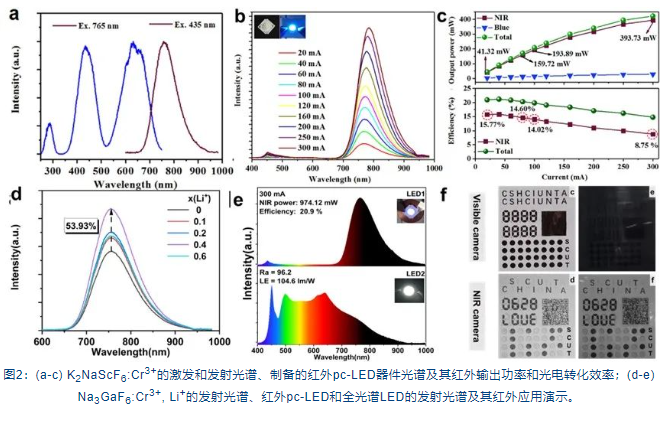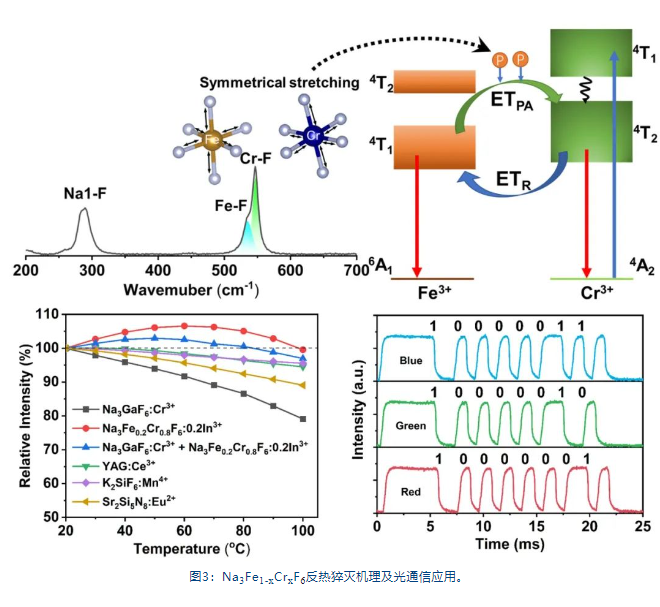16
2024
-
12
Research on LED using Cr³⁺ activated broadband near-infrared fluoride phosphors
Author:
related research on Cr-activated broadband near-infrared fluoride phosphors.By optimizing the synthesis method of fluoride phosphors and employing structural design and spectral tuning methods, high-efficiency luminescent and thermally stable Cr-activated broadband near-infrared fluoride phosphors have been developed, providing feasible ideas for the development of new types of high-performance near-infrared fluorescent materials for LEDs.The discovery of efficient broadband near-infrared emitting materials is of urgent and critical significance for constructing pc-LED near-infrared light sources and emerging applications. Our research group first synthesized a series of near-infrared emitting hexafluorides A2BMF6:Cr (A = Na, K, Rb, Cs; B = Li, Na, K, Cs; M = Al, Ga, Sc, In) using a universal ammonium salt-assisted synthesis strategy, with peak wavelengths ranging from 733 to 801 nm and half-peak widths adjustable from 98 to 115 nm.Thanks to the pre-ammoniation effect of trivalent metal sources (M-site ions), Cr can be more effectively doped into A, while avoiding the formation of competing phases. Among them, NaScF shows the best luminescent performance, with a luminescent spectrum covering 650-1000 nm, a peak wavelength of ~774 nm, a half-peak width of approximately 108 nm, and internal and external quantum efficiencies reaching 91.5% and 40.82%, respectively. The broadband near-infrared pc-LED device made by packaging with blue light chips has a near-infrared output power of about 291.05 mW and a photoelectric conversion efficiency of 20.94% under a driving current of 100 mA, providing a feasible solution for high-power near-infrared LED light source applications.Due to the low phonon energy of fluorides and relatively weak electron-phonon coupling effects, our research group also designed and synthesized KNaScF series near-infrared phosphors, which emit broadband near-infrared light with a peak emission of about 765 nm and a half-width of 100 nm under blue light excitation. The quantum efficiency reaches 74%, and the emission intensity at 150°C can maintain 89.6% of that at room temperature, indicating excellent thermal stability.State Key Laboratory of Luminescent Materials and Devices, South China University of Technology, Institute of Optical Communication MaterialsBased on the KNaScF series phosphors, a near-infrared pc-LED device with an output power of 159.72 mW and a photoelectric conversion efficiency of about 14.60% was prepared. In addition, using high-power near-infrared fluorescent conversion LED devices as lighting sources, clear and rapid venous imaging and recognition of fingers, palms, wrists, and arms were achieved.Furthermore, to further enhance the luminescent performance of fluoride phosphors, the research group started from the local structure regulation of the luminescent ion Cr, employing a Li+ co-doping strategy to achieve efficient and stable broadband near-infrared luminescence in the fluoride NaGaN system, with an internal quantum efficiency of 95.8% and an external quantum efficiency of 38.3%. It also possesses good luminescent thermal stability and moisture resistance.State Key Laboratory of Luminescent Materials and Devices, South China University of Technology, Institute of Optical Communication MaterialsBy combining Na with blue InGaN chips, a high-power infrared LED device with an output power of 974.12 mW and a photoelectric conversion efficiency of 20.9% was developed, and based on this, a special information encryption/decryption technology suitable for fast and long-distance recognition by machines was realized.The issue of fluorescence thermal quenching is also a major factor hindering the application development of infrared light sources. To address this issue, our research group used a Cr/Fe co-doping strategy to achieve anti-thermal quenching broadband near-infrared luminescence in fluoride phosphors by controlling the forward resonant energy transfer from Cr to Fe and the reverse phonon-assisted energy transfer from Fe to Cr.In the NaFe1-xCrxF phosphors, anti-thermal quenching near-infrared luminescence was achieved, which can even maintain its initial luminescence intensity at 200°C. Moreover, anti-thermal quenching near-infrared luminescence in Na, K用近红外荧光材料提供了可行思路。
高效宽带近红外发射材料的发现对于构建pc-LED近红外光源和新兴应用具有迫切和关键的意义。本课题组首先采用普适性的铵盐辅助合成策略合成一系列近红外发射的六氟化物A2BMF6:铬State Key Laboratory of Luminescent Materials and Devices, South China University of Technology, Institute of Optical Communication Materials(A = Na, K, Rb, Cs;B = Li、Na、K、Cs;M = Al, Ga, Sc, In),它们的峰值波长在733 ~ 801 nm,半峰宽在98 ~ 115 nm可调。得益于三价金属源(M位离子)的预氨化作用,CrState Key Laboratory of Luminescent Materials and Devices, South China University of Technology, Institute of Optical Communication Materials可以更有效地掺杂到A2BMF6中,同时避免竞争相的生成。其中,NaDue to its suitability for blue LED excitation and tunable broadband near-infrared emission (700~1200 nm), Cr3+ is currently the most widely studied activator ion for broadband near-infrared luminescent materials.ScF6:铬State Key Laboratory of Luminescent Materials and Devices, South China University of Technology, Institute of Optical Communication Materials展现出最优异的发光性能,发光谱覆盖650-1000nm,峰波长~774 nm, 半峰宽≈108 nm,内外量子效率分别高达91.5%和40.82%。结合蓝光芯片封装制成的宽带近红外 pc-LED器件,在100mA驱动电流下,近红外输出功率约为291.05 mW,光电转换效率为20.94%。为实现高功率近红外LED光源的应用提供了可行方案。

由于氟化物较低的声子能量和相对较弱的电子-声子耦合效应,本课题组还设计合成了K2NaScF 系列6:铬State Key Laboratory of Luminescent Materials and Devices, South China University of Technology, Institute of Optical Communication Materials近红外荧光粉,该荧光粉在蓝光激发下,发射峰值约为765 nm,半高宽为100 nm的宽带近红外光。量子效率高达74%,在150°C时的发射强度可以保持室温时的89.6%,表明其具有优异的热稳定性。基于K2NaScF系列6:铬State Key Laboratory of Luminescent Materials and Devices, South China University of Technology, Institute of Optical Communication Materials荧光粉制备了近红外输出功率为159.72 mW,光电转换效率约为14.60%的近红外pc-LED器件。此外,利用大功率近红外荧光转换LED器件作为照明光源,实现了手指、手掌、手腕和手臂的清晰快速静脉成像和识别。此外,为进一步提升氟化物荧光粉的发光性能,课题组从发光离子CrState Key Laboratory of Luminescent Materials and Devices, South China University of Technology, Institute of Optical Communication Materials的局域结构调控出发,采用Li+共掺策略在氟化物NaDue to its suitability for blue LED excitation and tunable broadband near-infrared emission (700~1200 nm), Cr3+ is currently the most widely studied activator ion for broadband near-infrared luminescent materials.氮化镓 (Ga6:铬State Key Laboratory of Luminescent Materials and Devices, South China University of Technology, Institute of Optical Communication Materials李+体系中实现了高效高稳定宽带近红外,具有95.8%的内量子效率和38.3%的外量子效率。同时兼具良好的发光热稳定性和耐湿性。通过将NaDue to its suitability for blue LED excitation and tunable broadband near-infrared emission (700~1200 nm), Cr3+ is currently the most widely studied activator ion for broadband near-infrared luminescent materials.氮化镓 (Ga6:铬State Key Laboratory of Luminescent Materials and Devices, South China University of Technology, Institute of Optical Communication Materials李+与蓝光InGaN芯片相结合,研制出了近红外输出功率达974.12 mW、光电转换效率20.9%的大功率红外LED器件,并在此基础上实现了一种适用于机器快速、远距离识别的特殊信息加密/解密技术。

荧光热猝灭问题同样是阻碍红外光源应用发展的一大因素。针对该问题,本课题组使用CrState Key Laboratory of Luminescent Materials and Devices, South China University of Technology, Institute of Optical Communication Materials/铁State Key Laboratory of Luminescent Materials and Devices, South China University of Technology, Institute of Optical Communication Materials共掺策略,在氟化物荧光粉中实现了反热猝灭宽带近红外发光,通过控制CrState Key Laboratory of Luminescent Materials and Devices, South China University of Technology, Institute of Optical Communication Materials→FeState Key Laboratory of Luminescent Materials and Devices, South China University of Technology, Institute of Optical Communication Materials的正向共振能量传递和FeState Key Laboratory of Luminescent Materials and Devices, South China University of Technology, Institute of Optical Communication Materials→CrState Key Laboratory of Luminescent Materials and Devices, South China University of Technology, Institute of Optical Communication Materials的反向声子辅助能量传递,在 NaDue to its suitability for blue LED excitation and tunable broadband near-infrared emission (700~1200 nm), Cr3+ is currently the most widely studied activator ion for broadband near-infrared luminescent materials.铁1 倍铬xF6荧光粉中实现了反热猝灭近红外发光,甚至在200°C时还能保持其初始的发光强度。此外,反热猝灭近红外发光在NaDue to its suitability for blue LED excitation and tunable broadband near-infrared emission (700~1200 nm), Cr3+ is currently the most widely studied activator ion for broadband near-infrared luminescent materials.氮化镓 (Ga6:铬State Key Laboratory of Luminescent Materials and Devices, South China University of Technology, Institute of Optical Communication Materials铁State Key Laboratory of Luminescent Materials and Devices, South China University of Technology, Institute of Optical Communication Materials、K2NaScF 系列6:铬State Key Laboratory of Luminescent Materials and Devices, South China University of Technology, Institute of Optical Communication Materials铁State Key Laboratory of Luminescent Materials and Devices, South China University of Technology, Institute of Optical Communication MaterialsThis indicates that the strategy has universality. More importantly, by combining anti-thermal quenching phosphors with blue InGaN chips, a near-infrared pc-LED device with a photoelectric conversion efficiency of up to 19.13%@20 mA was prepared, achieving a novel application in coded wireless optical communication. This lays the foundation for exploring near-infrared phosphors with anti-thermal quenching luminescent properties.

铬State Key Laboratory of Luminescent Materials and Devices, South China University of Technology, Institute of Optical Communication MaterialsThe emission spectrum of activated fluoride phosphors usually only covers the near-infrared I region (700-1000 nm). How to achieve near-infrared II emission (1000-1350 nm) through wavelength tuning is also an important topic. Our research group has developed a new type of CrState Key Laboratory of Luminescent Materials and Devices, South China University of Technology, Institute of Optical Communication Materialsdoped fluoride phosphor LiInF4:铬State Key Laboratory of Luminescent Materials and Devices, South China University of Technology, Institute of Optical Communication Materials, using a site-selective strategy to achieve tunable emission from the near-infrared I region to the near-infrared II region. By changing the volume ratio of HF to H2O in the synthesis solution, near-infrared emission was achieved from a peak of 818 nm to 1000 nm, with a maximum full width at half maximum of 220 nm. Density functional theory (DFT) calculations and experimental analysis indicate that the emissions in the near-infrared I and II regions come from CrState Key Laboratory of Luminescent Materials and Devices, South China University of Technology, Institute of Optical Communication Materialsions at In+and LiState Key Laboratory of Luminescent Materials and Devices, South China University of Technology, Institute of Optical Communication Materialssites in the fluoride. The relatively low local symmetry is a major factor in achieving CrState Key Laboratory of Luminescent Materials and Devices, South China University of Technology, Institute of Optical Communication Materialsnear-infrared II emission. This work also provides new insights into the luminescent regulation of CrState Key Laboratory of Luminescent Materials and Devices, South China University of Technology, Institute of Optical Communication Materialsions.
After several years of development, many CrState Key Laboratory of Luminescent Materials and Devices, South China University of Technology, Institute of Optical Communication Materialsactivated near-infrared fluorescent materials have been reported, and they have become the mainstream solution for near-infrared fluorescent materials used in LEDs. However, there are still few high-performance near-infrared phosphor systems that meet commercial needs, and in the future, it is still necessary to develop CrState Key Laboratory of Luminescent Materials and Devices, South China University of Technology, Institute of Optical Communication Materialsactivated broadband near-infrared phosphors that combine high luminous efficiency and excellent anti-thermal quenching performance to meet the application needs of pc-LED devices and promote the development of technologies such as infrared imaging and infrared spectral detection. In addition, to meet more diverse infrared detection needs, some studies are gradually pursuing longer wavelength infrared emissions. Currently, reported CrState Key Laboratory of Luminescent Materials and Devices, South China University of Technology, Institute of Optical Communication Materialsdoped fluoride materials typically have emission peaks less than 800 nm. How to broaden the spectral range through spectral tuning strategies to achieve near-infrared II region (>1000 nm) emission is also of great significance for future research and development.
LATEST NEWS
2025-01-09
Design and Development of Full-Spectrum Photodetectors
In recent years, the booming optoelectronic industry has changed the world and extended into many aspects of life. Among them, photodetectors (PDs) with a wide response bandwidth from deep ultraviolet to visible to near-infrared serve as important optoelectronic components and play a key role in daily life.
2025-01-08
Black arsenene multi-spectral integrated field-effect transistors, aiding high-resolution imaging and enhanced secure communication.
With the development of modern communication technology, the demand for broadband, room-temperature infrared, and terahertz (THz) detectors has rapidly increased. These detectors play a crucial role in fields such as telecommunications, security inspection, non-destructive testing, and medical diagnostics. However, existing optical detectors face challenges such as high intrinsic dark current and the need for low-temperature cooling, which limit their efficiency in detecting low-energy photons. Particularly in the terahertz band, the photon energy is insufficient to excite electron transitions from the valence band maximum (VBM) to the conduction band minimum (CBM), making effective optoelectronic conversion difficult. Therefore, researchers have been seeking ultra-broadband detectors that can operate at room temperature and respond to wavelengths ranging from visible light to the terahertz band.
2024-12-30
Laser-based tiered neurons achieve high-speed reservoir computing.
Neuromorphic computing is a computational paradigm that simulates the functions and architecture of biological neurons. A single biological neuron is a powerful computational unit with information processing capabilities, information transmission abilities, and memory functions. Therefore, it is crucial to design a photonic neuromorphic processor that can truly emulate the powerful computational functions of biological neurons.
2025-01-01
Design and Development of Full-Spectrum Photodetectors
In recent years, the rapidly growing optoelectronic industry has changed the world and extended into many aspects of life. Among them, photodetectors (PDs) with a wide spectral response from deep ultraviolet to visible to near-infrared serve as important optoelectronic components and play a key role in daily life.
2024-12-31
High-sensitivity quantum dot photodetectors from deep ultraviolet to near-infrared
In recent years, the rapidly growing optoelectronic industry has changed the world and extended into many aspects of life. Among them, photodetectors (PD) with deep ultraviolet-visible-near infrared full spectrum detection response serve as important optoelectronic components, playing a key role in daily life.

